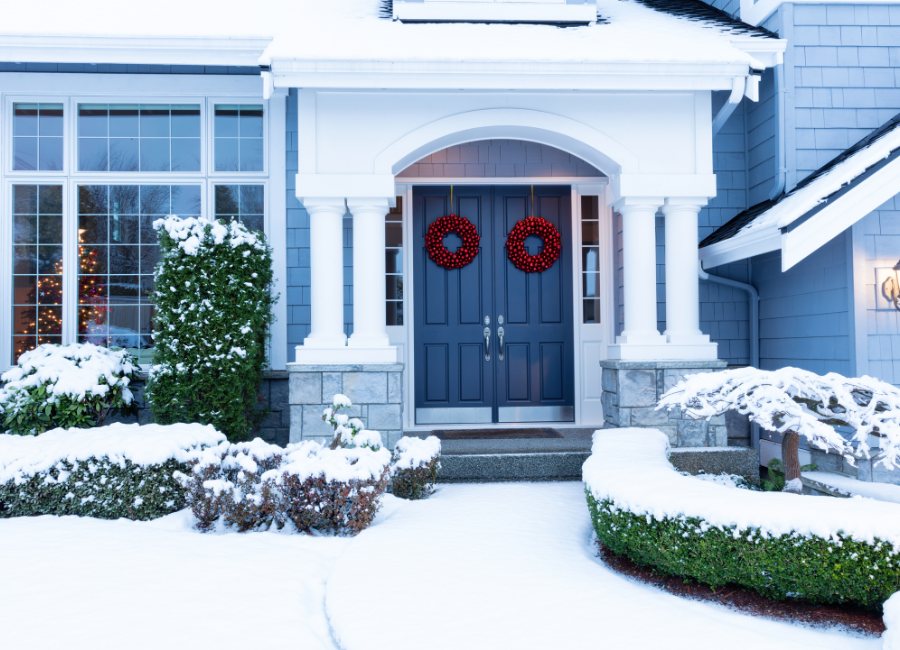Essential Steps to Winterize Doors and Windows
Welcome, dear readers, to our guide on winterizing your home—your key to a cozy and comfortable winter season. As the temperatures drop, it’s time to ensure that your home becomes a warm haven for you and your loved ones. Join us on this journey to chill-proof your space, starting with the essential steps to winterize your doors and windows.
The Significance of Winterize Doors and Windows
Winterizing is not just a seasonal chore; it’s a strategic move towards enhancing the energy efficiency and comfort of your home. As the chill sets in, our guide will walk you through the benefits of taking proactive measures to winterize your doors and windows. From keeping the cold drafts at bay to optimizing your home’s heating system, the significance of winterizing goes beyond just warmth—it’s about creating a snug sanctuary that lasts throughout the winter months. Let’s explore how these essential steps can make a world of difference in your winter experience.
Assessing Your Doors and Windows
Inspection Checklist
Before diving into winterization efforts, let’s begin with a comprehensive inspection of your doors and windows. Use this checklist to evaluate their current condition:
- Visual Inspection:
- Check for visible cracks, gaps, or signs of wear on the door and window frames.
- Examine the condition of the glass for any damage or issues.
- Door and Window Seals:
- Inspect the seals around doors and windows for wear and tear.
- Ensure that weather stripping is intact and functioning properly.
- Hardware Check:
- Test the functionality of door and window hardware, including handles, locks, and hinges.
- Tighten any loose screws or bolts.
- Frame Integrity:
- Assess the overall integrity of door and window frames.
- Look for warping or damage that could affect their ability to seal properly.
- Insulation Evaluation:
- Check the insulation around doors and windows.
- Verify that there are no gaps or missing insulation.
Identifying Drafts and Leaks
Drafts and leaks are common culprits when it comes to losing heat in your home. Here’s how you can pinpoint and address them:
- Feel for Drafts:
- On a windy day, run your hand along the edges of doors and windows to feel for drafts.
- Pay attention to areas where you sense a noticeable temperature drop.
- Candle Test:
- Light a candle and hold it near the edges of doors and windows.
- Watch for any flickering, which indicates a draft.
- Inspect Common Problem Areas:
- Check areas where different materials meet, such as where the window frame meets the wall.
- Inspect the bottom of doors and windows, as these areas are prone to drafts.
- Use a Smoke Pencil:
- On a non-windy day, use a smoke pencil to observe the movement of smoke around doors and windows.
- Pay attention to any unusual patterns, as they may indicate drafts.
By conducting a thorough assessment using this checklist, you’ll gain insights into the current state of your doors and windows, setting the stage for effective winterization. In the next sections, we’ll delve into sealing and insulation methods to address any issues you may uncover.
Sealing and Insulation for Winterize Doors and Windows
Weather Stripping
Preventing Drafts and Maintaining Warmth
Weather stripping is your first line of defense against drafts and chilly air infiltrating your home. Its primary role is to create a tight seal between movable components—like doors and windows—and their respective frames. Here’s why it matters:
- Sealing Gaps: Weather stripping fills the gaps around doors and windows, preventing cold air from entering and warm air from escaping.
- Energy Efficiency: By eliminating drafts, weather stripping contributes to the overall energy efficiency of your home, reducing the load on your heating system.
- Cost Savings: An airtight seal means less energy is needed to maintain a comfortable temperature, translating into potential cost savings on your energy bills.
Tip for Readers: Regularly check the condition of weather stripping. Over time, it may wear out or become damaged. Replace any worn or ineffective weather stripping to ensure optimal performance.
Caulking
Importance of Caulking and Effective Application Tips
Caulking is a versatile solution for sealing gaps and cracks around non-moving parts, such as window frames and door casings. Here’s why it’s crucial:
- Closing Gaps: Caulk is effective in closing small gaps and cracks that may not be suitable for weather stripping.
- Waterproofing: It serves as a barrier against water infiltration, preventing potential damage to your home’s structure.
- Enhanced Insulation: By sealing gaps, caulking contributes to better insulation, helping to maintain a consistent indoor temperature.
Tips for Effective Caulking:
- Choose a high-quality, paintable caulk suitable for your specific needs.
- Clean and dry the surfaces before applying caulk for better adhesion.
- Use a caulking gun for precise application, and smooth the caulk with a wet finger or caulk smoother.
Insulating Windows
Exploring Window Insulation Methods
Windows are notorious for letting in drafts, but with the right insulation methods, you can mitigate this issue effectively. Consider the following options:
- Thermal Curtains: Heavy, insulated curtains provide an additional barrier against cold air. Close them during the night to trap warmth inside.
- Window Films: Transparent films applied to the glass create an extra layer of insulation. They reduce heat loss while allowing natural light to filter through.
- Draft Snakes: Placing draft snakes along windowsills or at the bottom of doors helps block cold air from seeping in.
These methods work in harmony with weather stripping and caulking to create a comprehensive insulation strategy for your windows.
Sealing and insulating your doors and windows is a proactive step towards creating a warm and energy-efficient home. In the next section, we’ll delve into maintaining and optimizing your door and window hardware for smooth operation.
Door and Window Hardware Maintenance
Checking Seals and Gaskets
Inspecting and Maintaining Seals and Gaskets
Seals and gaskets play a crucial role in maintaining the integrity of your doors and windows. Regular inspection and maintenance are essential to ensure optimal performance. Here’s a step-by-step guide for readers:
- Visual Inspection:
- Examine the seals and gaskets around doors and windows for any visible wear, tears, or damage.
- Pay attention to areas where seals meet the frame, ensuring there are no gaps.
- Cleaning:
- Clear any debris or dirt accumulated on seals and gaskets.
- Use a mild detergent and a soft brush to clean the surfaces.
- Weather Stripping Check:
- Confirm that weather stripping, if part of the sealing mechanism, is intact and functioning.
- Replace any weather stripping that shows signs of wear or deterioration.
- Gasket Flexibility:
- Gently press on the gaskets to ensure they maintain flexibility.
- Stiff or brittle gaskets may need replacement to maintain an effective seal.
Maintenance Tip: Apply a silicone-based lubricant on gaskets to keep them supple and resistant to harsh weather conditions.
Lubricating Hinges and Tracks
Significance of Lubricating Door and Window Hinges and Tracks
Smoothly operating hinges and tracks are essential for the proper functioning of doors and windows. Regular lubrication prevents friction, reduces wear, and ensures a quiet and efficient movement. Here’s why it matters:
- Friction Reduction: Lubrication minimizes friction between hinges and tracks, preventing unnecessary wear and tear.
- Noise Reduction: Properly lubricated hinges and tracks result in quieter door and window operation.
- Prolonged Lifespan: Regular lubrication extends the lifespan of hinges and tracks, saving you from premature replacements.
How to Lubricate:
- Clean First: Remove dirt and debris from hinges and tracks using a brush or compressed air.
- Choose the Right Lubricant: Use a silicone-based or Teflon-based lubricant for smooth application.
- Apply Liberally: Place a small amount of lubricant on hinge pivot points and along the tracks.
- Operate the Door or Window: Open and close the door or window several times to distribute the lubricant evenly.
By incorporating these checks and lubrication practices into your routine maintenance, you ensure that your door and window hardware operates seamlessly. In the next section, we’ll explore the advantages of upgrading to energy-efficient doors and windows.
Upgrading to Energy-Efficient Options
Energy-Efficient Doors
Benefits of Upgrading and Popular Options
Upgrading to energy-efficient doors is a transformative step toward enhancing your home’s overall efficiency and comfort. Let’s delve into the advantages and popular options available:
Benefits:
- Improved Insulation: Energy-efficient doors often come with enhanced insulation features, reducing heat transfer and keeping your home comfortably warm.
- Lower Energy Bills: By minimizing heat loss, these doors contribute to lower energy consumption, translating into potential cost savings on your utility bills.
- Enhanced Security: Many energy-efficient doors are designed with robust materials and advanced locking mechanisms, providing an added layer of security for your home.
- Noise Reduction: The insulation properties of energy-efficient doors also contribute to a quieter indoor environment by minimizing external noise.
Popular Options:
- Fiberglass Doors: Known for their durability and insulation properties, fiberglass doors are resistant to warping, cracking, and rotting.
- Steel Doors with Insulation: Steel doors with a layer of insulation offer excellent thermal performance and are highly resistant to harsh weather conditions.
- Wood-Clad Doors: Combining the aesthetic appeal of wood with modern insulation features, wood-clad doors provide a classic look with enhanced efficiency.
Window Upgrades
Exploring Energy-Efficient Window Options
Windows are significant contributors to energy efficiency. Consider these energy-efficient window options to optimize your home’s thermal performance:
1. Double-Pane Windows:
- Double-pane windows consist of two layers of glass with a sealed space between them, providing better insulation than single-pane windows.
2. Low-E Glass:
- Low-emissivity (Low-E) glass has a thin coating that reflects infrared light, reducing heat transfer and improving energy efficiency.
3. Triple-Pane Windows:
- With an additional layer of glass, triple-pane windows offer enhanced insulation and noise reduction compared to double-pane alternatives.
4. Vinyl Windows:
- Vinyl windows are known for their excellent thermal performance, low maintenance requirements, and resistance to condensation.
5. Energy Star Rated Windows:
- Look for windows with the Energy Star label, indicating compliance with energy efficiency standards set by the Environmental Protection Agency (EPA).
Benefits of Energy-Efficient Windows:
- Year-Round Comfort: Energy-efficient windows help maintain a consistent indoor temperature, keeping your home cool in the summer and warm in the winter.
- UV Protection: Low-E glass reduces UV radiation, protecting your furnishings and decor from sun damage.
- Environmental Impact: By reducing energy consumption, energy-efficient windows contribute to a smaller carbon footprint.
Upgrading both doors and windows to energy-efficient options is a holistic approach to optimizing your home’s energy performance. In the next section, we’ll explore ways to winterize your entryways for added insulation and comfort.
Winterizing Your Entryways
Draft Stoppers
Introducing the Use of Draft Stoppers for Doors
As we focus on creating a cozy and energy-efficient home, paying attention to your entryway is paramount. Draft stoppers for doors are simple yet effective solutions to prevent cold air from sneaking into your living space. Here’s how they work and why they matter:
How Draft Stoppers Work:
- Draft stoppers, also known as door snakes or draft blockers, are long fabric tubes filled with insulating material.
- Placed along the bottom of doors, they create a barrier that stops cold drafts from entering and warm air from escaping.
Benefits:
- Energy Savings: By blocking drafts, these stoppers contribute to energy efficiency, reducing the workload on your heating system.
- Easy Installation: Draft stoppers are a cost-effective and easy-to-install solution for any homeowner.
- Versatility: They come in various designs, allowing you to choose one that complements your decor while serving a practical purpose.
Installation Tips:
- Measure the Door Width: Ensure the draft stopper is the correct length for the door it will be placed on.
- Positioning: Place the draft stopper along the bottom of the door, ensuring a snug fit.
- Adjust as Needed: Make adjustments to the stopper to guarantee it effectively blocks drafts without impeding the door’s movement.
Threshold Seals
Explaining the Importance and Installation of Threshold Seals
Threshold seals are an integral part of winterizing your entryways, providing an additional line of defense against cold air infiltration. Let’s explore their significance and how to install them:
Importance of Threshold Seals:
- Thresholds are the bottom portion of a door frame, and seals play a vital role in preventing drafts, moisture, and even pests from entering your home.
- When properly installed, threshold seals create a tight seal between the bottom of the door and the threshold, minimizing heat loss.
Installation Steps:
- Clean the Area: Ensure the area where the threshold seal will be installed is clean and free of debris.
- Measure and Cut: Measure the width of the door and cut the threshold seal to the appropriate size.
- Secure in Place: Install the threshold seal by securing it to the bottom of the door, making sure it forms a snug seal when the door is closed.
- Test the Seal: Close the door and check for any gaps. Adjust the threshold seal if needed to achieve a tight seal.
Tip for Readers: Choose a threshold seal that is appropriate for the type of door and the specific conditions it will face, such as exposure to the elements.
Winterizing your entryways with draft stoppers and threshold seals is a practical and effective way to maintain warmth and comfort in your home. In the next section, we’ll explore additional tips for winterizing doors and windows for a comprehensive approach.
Additional Tips for Winter Comfort
Window Treatments for Winterize Doors and Windows
Discussing the Role of Window Treatments in Retaining Heat
Window treatments go beyond adding a touch of style to your home—they play a crucial role in retaining heat and enhancing insulation during the winter months. Let’s explore their significance and how they contribute to your winter comfort:
Benefits of Window Treatments:
- Insulation: Thick curtains or drapes act as insulators, creating an additional barrier against cold air coming in and warm air escaping.
- Reduced Heat Loss: Closing window treatments at night minimizes heat loss, especially in rooms with large or drafty windows.
- Privacy and Ambiance: Beyond insulation, window treatments enhance privacy and create a cozy ambiance in your living spaces.
Recommended Window Treatments:
- Heavy Curtains: Opt for curtains made from thick, insulating fabrics to effectively trap heat.
- Thermal Blinds: These blinds have insulating properties, reducing heat transfer through the windows.
- Layered Options: Combine curtains with blinds or shades for a layered approach to insulation.
Tip for Readers: Open window treatments during the day to allow sunlight to naturally warm your home. Close them in the evening to retain the accumulated heat.
Using Draft Blockers
Providing Information on Employing Draft Blockers for Added Insulation
Draft blockers, similar to those used for doors, can also be employed strategically around windows to prevent cold air infiltration. Here’s how draft blockers contribute to enhanced insulation:
Placement Strategies:
- Window Sills: Place draft blockers on window sills to block drafts that may seep in from the bottom.
- Along Edges: Position draft blockers along the edges of windows where there may be gaps or spaces.
- Window Frame Gaps: Identify any gaps in the window frame and use draft blockers to seal these areas.
Benefits of Draft Blockers for Windows:
- Cost-Effective Solution: Draft blockers are a budget-friendly way to address drafts without the need for extensive renovations.
- Easy to Install: They can be easily positioned and repositioned as needed, making them a flexible solution.
Tip for Readers: Consider making or customizing draft blockers to match your home decor. They can be both functional and visually appealing.
By incorporating these additional tips for winter comfort, you’ll create a more resilient barrier against the cold, ensuring a snug and warm home. In the final section, we’ll wrap up our guide and emphasize the importance of a well-insulated home for winter.





